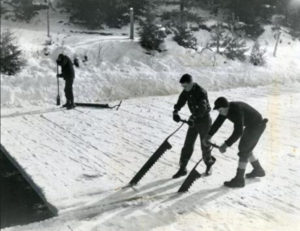NATURAL ICE HARVESTING
This past summer, as part of the Eastern Invitational Steam Car Tour, tour participants had the opportunity to visit the Antique Ice Tool Museum in West Chester, PA. The old barn, now converted into a museum, is full of artifacts of the 1800s, when natural ice was harvested from local creeks and ponds and stored over the summer months for consumption and for keeping food cold. Ice harvesting of America’s ponds and lakes became one of the nation’s biggest export incomes during the late 1800s, when more than two million tons of ice were harvested annually. When ammonia refrigeration plants began making year-round ice at the very end of the 19th century, more than 20 million tons of natural-formed ice were being harvested or produced commercially.
 If one researches outdoor temperatures in the late 1800s, you will find weeks of below-freezing temperatures occurred during winter months in our area. This was more than sufficient “cold” to freeze the Red Clay Creek to a sufficient thickness that it could be harvested for ice. In February 1887, the Delaware General Assembly authorized the formation of the Greenbank Ice Company of Marshallton, DE, for the harvesting of ice on the Red Clay Creek. The Baltimore & Ohio Railroad is documented by the Evening Journal as harvesting 12-inch thick pond ice held behind the Greenbank Mill’s dam on January 14, 1893. On January 8, 1900, the Evening Journal documented that 6- to 8-inch thick ice was being harvested from the large lake at Brandywine Springs Amusement Park. The Mitchell family harvested ice in winter months for storage in the ice house alongside the farmhouse and behind the creamery, which could be used for keeping milk cold. No doubt the Marshalls harvested ice for storage from the tranquil waters behind their mill dams before the age of refrigeration.
If one researches outdoor temperatures in the late 1800s, you will find weeks of below-freezing temperatures occurred during winter months in our area. This was more than sufficient “cold” to freeze the Red Clay Creek to a sufficient thickness that it could be harvested for ice. In February 1887, the Delaware General Assembly authorized the formation of the Greenbank Ice Company of Marshallton, DE, for the harvesting of ice on the Red Clay Creek. The Baltimore & Ohio Railroad is documented by the Evening Journal as harvesting 12-inch thick pond ice held behind the Greenbank Mill’s dam on January 14, 1893. On January 8, 1900, the Evening Journal documented that 6- to 8-inch thick ice was being harvested from the large lake at Brandywine Springs Amusement Park. The Mitchell family harvested ice in winter months for storage in the ice house alongside the farmhouse and behind the creamery, which could be used for keeping milk cold. No doubt the Marshalls harvested ice for storage from the tranquil waters behind their mill dams before the age of refrigeration.
Does anyone still harvest ice naturally in the U.S., and if your answer is “yes,” where is it done?
Answer
 Natural ice is routinely harvested in Maine, Montana, New Hampshire, and Wisconsin as well as Ontario, Canada, at least in 2019. The 190-year-old Maine ice harvest is performed by the Thompson Ice House Harvesting Museum. Around 7 tons of ice is harvested in mid-February and stored until the July ice cream social, where the ice is used to make ice cream and for snow cones.
Natural ice is routinely harvested in Maine, Montana, New Hampshire, and Wisconsin as well as Ontario, Canada, at least in 2019. The 190-year-old Maine ice harvest is performed by the Thompson Ice House Harvesting Museum. Around 7 tons of ice is harvested in mid-February and stored until the July ice cream social, where the ice is used to make ice cream and for snow cones.
The best known and perhaps largest natural ice harvest for keeping foods cold occurs annually at Squam Lake near Holderness, New Hampshire. Once a commercial ice operation first operated in 1897, today the ice is harvested using more modern methods for use by the Rockywold-Deephaven Camps, a resort community open only during the summer months. Roughly 3,600 ice blocks weighing 120 to 150 pounds (roughly 16″ x 19″ by the ice’s thickness somewhere between 12″ and 15″) are harvested in mid-January to mid-March each year for storage in one of two ice houses. The ice is used during the summer months to fill the “ice boxes” located in each of the cottages on the resort property. For more information visit their website.

